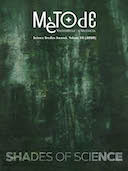Einstein and Nazi physics: When science meets ideology and prejudice
DOI:
https://doi.org/10.7203/metode.10.13472Keywords:
Albert Einstein, Nazism, anti-Semitism, science and ideology Abstract
Abstract
In the 1920s and 30s, in a Germany with widespread and growing anti-Semitism, and later with the rise of Nazism, Albert Einstein’s physics faced hostility and was attacked on racial grounds. That assault was orchestrated by two Nobel laureates in physics, who asserted that stereotypical racial features are exhibited in scientific thinking. Their actions show how ideology can infect and inflect science. Reviewing this episode in the current context remains an instructive and cautionary tale.
 Downloads
Downloads
 References
References
Cassidy, D. C. (2009). Beyond uncertainty: Heisenberg, quantum physics, and the bomb. New York: Bellevue Literary Press.
Clark, R. W. (1973). Einstein: The life and times. London: Hodder & Stoughton.
Einstein, A. (1949). The world as I see it.New York: Philosophical Library.
Einstein, A. (1954). Ideas and opinions. New York: Bonanza Books.
Folsing, A. (1998). Albert Einstein: A biography. Harmondsworth: Penguin.
Heilbron, J. L. (2000). The dilemmas of an upright man: Max Planck and the fortunes of German science. 2nd ed. Cambridge: Harvard University Press.
Hentschel, K. (Ed.). (1996). Physics and National Socialism: An anthology of primary sources. A. M. Hentschel (Transl.). Basel: Birkhauser Verlag.
Kershaw, I. (2008). Hitler, the Germans, and the final solution. New Haven: Yale University Press.
Kurlander, E. (2009). Living with Hitler.New Haven: Yale University Press.
Mosse, G. L. (Ed.). (1966). Nazi culture: Intellectual, cultural and social life in the Third Reich, p. 206. New York: Grosset & Dunlap.
Nathan, O., & Norden, H. (Eds.). (1963). Einstein on peace. New York: Simon & Schuster.
Rosbaud, P. (1945). Rosbaud correspondence and manuscripts 1945. (Series IV, Box 28, Folder 42). Samuel Goudsmit Papers. American Institute of Physics.
Szilard, L. (1979, March). Excerpts. Leo Szilard: His versions of the facts II. Bulletin of the Atomic Scientists, 35(3), p. 55–59.
Van Dongen, J. (2007). Reactionaries and Einstein’s fame: “German Scientists for the Preservation of Pure Science”, relativity, and the Bad Nauheim Meeting. Physics in Perspective, 9(2), 212–230. doi: 10.1007/s00016-006-0318-y
Walker, M. (1995). Nazi science: Myth, truth and the German atomic bomb. New York: Plenum.
Downloads
Published
How to Cite
-
Abstract3507
-
PDF1201
Issue
Section
License
![]()
All the documents in the OJS platform are open access and property of their respective authors.
Authors publishing in the journal agree to the following terms:
- Authors keep the rights and guarantee Metode Science Studies Journal the right to be the first publication of the document, licensed under a Creative Commons Attribution-NonCommercial-NoDerivatives 4.0 International License that allows others to share the work with an acknowledgement of authorship and publication in the journal.
- Authors are allowed and encouraged to spread their work through electronic means using personal or institutional websites (institutional open archives, personal websites or professional and academic networks profiles) once the text has been published.





